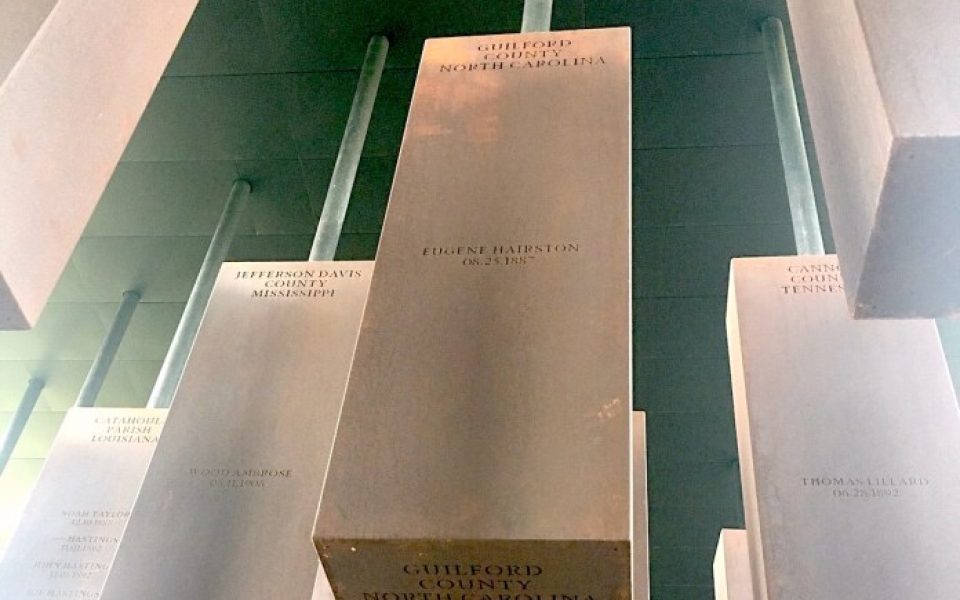Featured photo: The memorial for Eugene Hairston hangs in the Memorial for Peace and Justice in Montgomery, Ala. (photo courtesy of Guilford County Remembrance Project)
Thomas Frazier. Richard Cotton. Doyle Bryant. Elijah Church.
These are just a handful of the hundreds of black men who were lynched in North Carolina between the end of the Civil War and the beginning of World War II. These names are often lost to history, forgotten, their stories never told.
One name that a local coalition is looking to resurrect is Eugene Hairston — the only documented victim of a lynching in Guilford County.
According to recent investigative work done by members of the Guilford County Remembrance Project, Hairston was just a teenager — no more than 17 or 18 years old — when he was lynched in 1877 in Greensboro after being accused of attempted rape against a young, white woman.
On Monday evening, the coalition gave a presentation at Guilford College, where many of the members work.
Allison Spooner, an academic coach and tutor at the college, opened the evening by asking for a moment of silence, followed by a reading of victims’ names. Spooner also acknowledged up front the fact that the three speakers of the evening, including herself, are all white women.
“I think it’s important to acknowledge that in this room, that we are presenting, as white women, the death and suffering of a young black man,” Spooner said. “And there’s not really anything more that I can say about that except for to just acknowledge that and say that this work is messy and complex and even just talking about lynching can be traumatic for many people and part of that is because we live in a white-supremacist society still to this day. We have not moved on; we have not healed from our past.”
The work of the Guilford County Remembrance Project stems from a trip that some of the members took to Montgomery, Ala. in 2018, where they visited the Legacy Museum and National Memorial for Peace and Justice, both products of the Equal Justice Initiative founded and run by lawyer Bryan Stevenson of Just Mercy fame. The museum aims to educate visitors on the lasting effects of slavery in America, while the memorial calls attention to the country’s history of lynching. The latter is made from hundreds of dark, metal columns that hang from a vast sheet of metal that appears to float off the ground. Each column corresponds to a county where a lynching took place and has etched upon it, the names of the victims. The column for Guilford County has just one name carved into its surface: Eugene Hairston.


Since that trip, the group has been working towards three concrete goals set forth by the Equal Justice Initiative: collecting soil from the lynching site to be displayed alongside others at the museum in Montgomery, installing a historical marker in Greensboro at a prominent location to commemorate and explain how Hairston was killed, and the erection of a monument using a copy of the column that hangs at the site in Montgomery.

During the presentation on Monday, Sarah Thuesen, an assistant professor of history at Guilford College, explained the social and political landscape during the time when Hairston was killed.
“In 1877, African Americans were gaining ground in certain ways, in terms of politics and the economy,” Thuesen said.
She noted how black men were beginning to hold elected offices, and organizations like the North Carolina Industrial Association were founded to promote black economic progress. Black teachers were vocal about a state-supported black college, which eventually led to the opening of NC A&T University in 1891. Because of these instances of advancement, Thuesen said, there was a growing white backlash to black power.
“These lynchings were not just random acts of violence, I mean sometimes they were,” Thuesen said. “But this was also about power. This was a white backlash to rising black political and economic power.”
Against the backdrop of this growing resentment of black progress came the death and lynching of Eugene Hairston. On the evening of Aug. 23, 1877, according to white newspaper accounts, Mahala Sapp, a young white woman, was “accosted by a negro with evil purposes” in Kernersville, and within 30 minutes of news of the attempted rape, a mob had formed with the intention of killing Hairston.
One newspaper reported that those in favor of lynching Hairston were “the best citizens in Piedmont Carolina.” Local authorities transported him by train to Greensboro, where he was held in the local jail. Not long afterwards, the mob descended upon the building where Hairston was being held and forced their way inside, taking Hairston to a nearby schoolhouse where he was lynched and left as a community spectacle.
Using newspaper clippings and old maps, Terry Hammond, who works as director and curator of the art gallery at Guilford College, managed to narrow down the site where Hairston was killed. Formerly known as the “Little Brick School,” Hammond found out that the location is where the Presbyterian Church of the Covenant in the College Hill neighborhood is today. The plan, according to the group, is to gather soil from the site sometime in May to send it to the museum in Montgomery. After that, the group hopes to erect the historical marker in a prominent location within the city, then bring the twin monument back to a quieter, more introspective site for people to visit, and contemplate the life that was lost.

“Eugene Hairston was a kid,” Hammond said. “He was a person who had joys and sorrows in life. I want to learn as much about him as a human being rather than as just a statistic.”
After months of research, Hammond was even able to find one of Hairston’s descendants, an elderly woman named Dolores who still lives in Kernersville. She had never heard about Eugene, but she gave the group her blessing.
Mayor Nancy Vaughan, who attended the meeting, expressed interest in moving forward with the historical marker and wanting to help with the logistics. She said she had visited the museum in Montgomery just two weeks earlier and was moved by the memorial.
“When we got home… we wanted to learn about Eugene,” Vaughan said. “You don’t want to go on the trip and then not do anything about it. I think this is something that we need to follow up on. I think the city should assist in any way that we can to make this a reality.”
Vaughan said that the next steps are finding out how to make both the marker and the monument a reality. For Spooner and the rest of the coalition, the ultimate goal of the project is to educate the community.
“We have to grieve this part of our past,” Spooner said in the closing remarks. “We have to understand the truth and truly come around each other as a community so that we can bring about reconciliation and
healing.”
The Guilford County Remembrance Project is hosting another event entitled “Murder, Mayhem and Racial Terror: Why the Lynching of Eugene Hairston Still Matters,” on Wednesday at 7 p.m. at The Little Theatre on Bennett College’s campus. The event is free to attend.
To learn more about the project, visit their website or find them on Facebook.
Join the First Amendment Society, a membership that goes directly to funding TCB‘s newsroom.
We believe that reporting can save the world.
The TCB First Amendment Society recognizes the vital role of a free, unfettered press with a bundling of local experiences designed to build community, and unique engagements with our newsroom that will help you understand, and shape, local journalism’s critical role in uplifting the people in our cities.
All revenue goes directly into the newsroom as reporters’ salaries and freelance commissions.


Leave a Reply